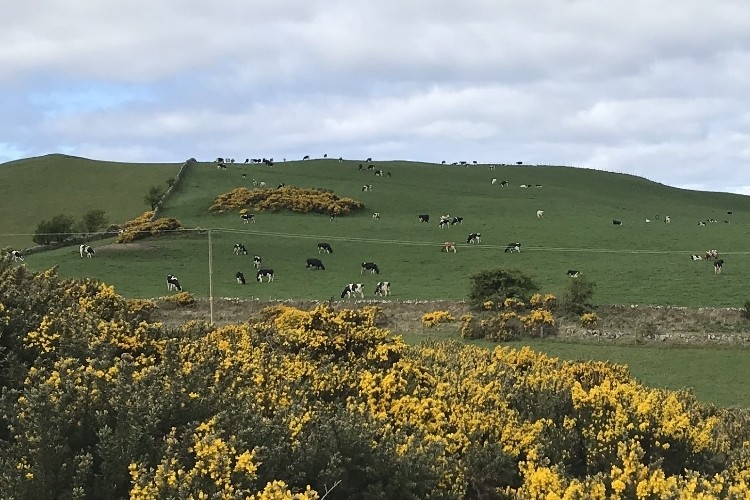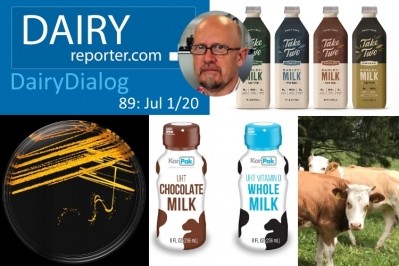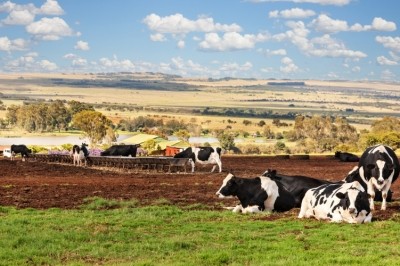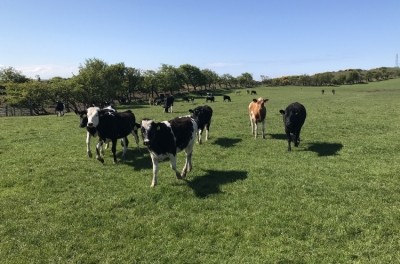Dairy sector takes issue with IATP report

The report noted that 13 of the world’s largest dairy corporations combined to emit more greenhouse gases (GHGs) in 2017 than major polluters BHP, the Australia-based mining, oil and gas giant or ConocoPhillips, the US-based oil company.
However, the dairy industry hit back, saying the report includes inaccuracies.
The 13 companies included in the report:
Amul
Groupe Lactalis
Saputo Inc.
Danone SA
Fonterra Co-Operative Group Ltd
Yili Group
Dairy Farmers of America
DMK
California Dairies
FrieslandCampina
Arla Foods
Nestlé
Dean Foods
The authors of the report said, unlike growing public scrutiny on fossil fuel companies, little public pressure exists to hold global meat and dairy corporations accountable for their emissions, even as scientific evidence mounts that our food system is responsible for up to 37% of all global emissions.
The total combined emissions of the largest dairy corporations rose by 11% in just two years (2015-2017) since the last IATP report, the authors said.
Even as governments signed the Paris Agreement in 2015 to significantly rein in global emissions, the 13 companies’ increase of 32.3m tonnes (MtCO2eq) of GHGs equates to the pollution stemming from 6.9m passenger cars driven in one year (13.6bn liters or 3.6bn gallons of gasoline). Some dairy companies increased their emissions by as much as 30% in the two-year period, the report claims.
The report said the emissions rise occurred amidst a crash in global dairy prices in 2015 and 2016, which was fueled partially by increased production from mega-dairies and global dairy corporations that dumped excess dairy into the global market, pushing prices down below the cost of production and forcing out many small to mid-sized dairy farmers.
Since the first global assessment in 2018 with GRAIN, Emissions Impossible: How big meat and dairy are heating up the planet, the global dairy industry has continued to expand and scale up into new territories through mergers and acquisitions, expanding its collective production by 8% in just two years, the organization said.
The IATP said none of the companies are required by law to publish or verify their climate emissions or present plans to help limit global warming to 1.5˚C. Fewer than half of these companies are publishing their emissions, and none of the 13 have committed to a clear and absolute reduction of emissions from their dairy supply chains or emissions from the animals themselves.
Emissions from dairy animals in the supply chain account for more than 90% of corporate dairy emissions. Three companies out of the 13 have pledged to address scope 3 (dairy supply chain) emissions to any degree.
Some companies track their supply chain emissions through “emissions intensity” reduction targets, however, the IATP said what ultimately counts for a warming climate is whether the companies are reducing their overall emissions at a scale that matters, not their emissions reductions per liter. For example, a FAO study reveals that while the industry reduced emission intensity by 11% between 2005-2015, its overall emissions increased by 18% in that same period.
The European Union (EU), US and New Zealand alone account for nearly half (46%) of all global dairy production. The companies headquartered in these and other industrialized countries account for the lion’s share of global dairy emissions, and these governments are the best placed to enact policies that enable what the IATP said is a just transition for dairy producers towards much more climate resilient and agroecological practices in line with ambitious 2030 and 2050 emissions reduction targets.
The report said the EU’s milk quota removal in 2015, along with other factors, contributed to the second global dairy crisis in 10 years. The EU accounts for more than a quarter of the world’s exports. Its dairy corporations remain competitive in the global market by paying EU farmers below the cost of production and dumping “cheap” dairy exports into developing country markets.
The IATP said if the EU is serious about its climate ambition, not only must it reform the Common Agriculture Policy (CAP) to incentivize environmental resilience, but it must also regulate the market so companies pay producers their cost of production plus a reasonable profit.
The report noted that in spite of 93% of family farms closing since the 1970s, overall dairy production in the US continues to rise due to new or expanding mega-dairies. These are often funded by outside investors and propped up by Farm Bill programs. The lack of environmental enforcement, particularly of their GHG emissions, further abets mega-dairies, the IATP said.
Half of New Zealand’s emissions come from the livestock sector, agricultural emissions having risen by 12% since 1990 with the doubling of its dairy herd and a 600% increase in fertilizer use. New Zealand exports 95% of its milk, largely through Fonterra, the world’s second largest dairy processor.
The report said Fonterra’s nearly 10,000 farmer shareholders incurred huge losses last year, calling into question Fonterra’s corporate structure and investment strategy. In 16 years (2003-2019), New Zealand’s on-farm debt increased by NZ$30.1bn. In 2019, New Zealand became the first country to set GHG reduction targets for agriculture in its new Climate Law.
The IATP said the solution is to redirect public funds away from industrial agriculture, regulating the public health, environmental and social impacts of this extractive model of production and designing incentives to regenerate rural communities through agroecology.
“Governments need to begin by integrating climate goals within their national-level farm policies. These climate goals should address strategies to build climate resilience and reduce emissions,” the IATP said.
“Critically, trade rules must be reformed, having thus far driven an export-focused agriculture system while ignoring the climate. International development aid also needs to support an integrated set of social and environmental measures for agroecological systems that support small-scale producers in the Global South.
“For a real climate revolution in the agriculture sector, governments have to transform farm and climate policy in a way that shifts power away from these corporate drivers. They must be courageous enough to enact policy change towards agroecological systems that empower rural producers to do the right thing for their families, communities and the planet.”
Industry response
DairyReporter contacted all 13 of the companies cited in the report, and the response to the report was swift and negative.
Arla Foods and DFA referred to a response from the International Dairy Federation (IDF) and Global Dairy Platform (GDP), which is reprinted here in full.
Saputo told DairyReporter, “Saputo recognizesthe environmental and sustainability challenges related to the use of natural resources in milk production and is committed to actively reducing GHG emissions throughout the value chain. Saputo’s carbon emissions have increased in recent years due to the acquisitions of several large dairy processors in Australia and the UK.
“In February 2020, Saputo announced a formal commitment to make significant and sustainable progress by 2025 on its global climate, water and waste performance. This represents another strong step in the Company’s journey to create shared value for its stakeholders through the Saputo Promise, its approach to social, environmental and economic performance.”
Carolyn Mortland, director global sustainability at Fonterra, told DairyReporter, “Addressing climate change is one of the most challenging global issues facing the dairy industry, and it’s a key focus for Fonterra.
“We’re focused on doing more to reduce our use of fossil fuels in transport and manufacturing and finding ways to manage and mitigate animal emissions on farm. A strong healthy environment is the foundation for a strong economy and sustainable dairy farming.
“However, the IATP Report contains several inaccuracies and we view it as a missed opportunity for real dialogue about solutions to climate change and creating a sustainable future for everyone. For example, the Fonterra emissions are significantly over reported (44m tonnes of C02-e rather than 22m).
“In contrast, a comprehensive and peer-reviewed report released earlier this year found that the carbon footprint of New Zealand’s on-farm milk supply is less than one-third of the global average and up to 30% lower than greenhouse gas footprints of European and North American milk production. A litre of milk produced in New Zealand creates 0.91 kg of CO2 emissions – compared to the global average of 2.5 kg of CO2 emissions.
“Over the past 25 years, New Zealand dairy farmers have reduced on-farm emissions intensity by about 20%. The strongest improvements were from 2007 to 2016. They’ve managed to do this by improving the efficiency of their farming operations.
“There is more work to be done but reports such as the IATP do little to contribute to public debate or new ideas.
“Milk and dairy products are an incredible source of essential nutrients we need in a balanced diet, helping people lead healthy and happy lives. This latest research shows New Zealand is producing some of the best milk with the lowest footprint.”
FrieslandCampina said the IATP report gives a distorted and unfair picture of the dairy industry.
“The authors of the report completely ignore the efforts of dairy companies such as FrieslandCampina to make dairy production more sustainable. The institute wrongly claims that all dairy companies involved are not doing anything to reduce greenhouse gases,” a company spokesperson said.
“This completely ignores the sustainability efforts of the Dutch dairy industry and FrieslandCampina in particular. FrieslandCampina has an extensive program called Foqus planet and works in close cooperation with its member dairy farmers to make dairy production more sustainable.
“FrieslandCampina is also involved in the Sustainable Dairy Chain, a partnership between Dutch dairy companies and dairy farmers to make dairy production more sustainable. One of the consequences of this is that the emission of greenhouse gases per kilogram of milk in the Netherlands between 2015 and 2017 (the period on which the researchers are focusing) has actually fallen by 9%. In 2018, (the last known reporting year) emissions will fall even further.
“In addition, the report wrongly assumes that the scale of the large dairy companies puts small locally operating dairy companies and local farmers at a disadvantage. FrieslandCampina's Dairy Development Programme is specifically intended to support and strengthen local milk production in less developed dairy countries.”
The cooperative added, “With our Dairy Development Programme, we train and improve the skills of dairy farmers in Asia, Africa and Eastern Europe with regard to sustainable and efficient farming processes. Since the start of the program in the 1980s, we have directly and indirectly reached more than 250,000 dairy farmers. The DDP supports local (often small) dairy farms in eight countries: China, Indonesia, Malaysia, Nigeria, Pakistan, Romania, Thailand and Vietnam.
“Our goal is to improve the quality of their milk, increase productivity per cow and support farmers in gaining access to the market. In order to achieve those goals, we focus on trainings, knowledge partnerships and projects aimed at improving the dairy farming infrastructure, such as the upgrading of milk collection centres. In this way, we contribute to food security, a more sustainable milk production and raising the living standards of the dairy farmers participating in the program.”
Response to report from GDP and IDF
The dairy sector is committed to producing nutritious foods in environmentally sound and responsible ways. As such, we welcome any opportunity to further the dialogue about solutions to climate change and creating a sustainable future for everyone. However, this report, while interesting, contains several inaccuracies and as such does not reflect the reality of the dairy sector.
Environmental Impact
Globally, all of agriculture accounts for 24% of greenhouse gas (GHG) emissions, and within that dairy is responsible for 2.7%. While the dairy sector is committed to sustainable development and decreasing our rate of emissions even further, this 2.7% emissions rate must be put into the context of emissions from other sectors, such as energy – 25%, business – 21% and transport – 14%. Especially when considering the positive impact dairy has on livelihoods and nutrition.
One of the key claims in this report is that the top 13 global dairy companies saw an 11% increase in GHG emissions between 2015 and 2017. This is misleading, as much of the increase can be accounted for by mergers and acquisitions by those companies. Annex 1 in the report even confirms this is simply an accounting change, and these are not new emissions.
The United Nations (UN) Food and Agriculture Organization’s (FAO) 2019 report, “Climate Change and the Global Dairy Sector,” was referenced. Key information about that report was left out, including the fact that it was multi-stakeholder study written by FAO. FAO found that between 2005-2015, milk production increased 30% globally in order to meet growing consumer demand. Absolute emissions rose 18% and emissions per unit of product declined by 11%. Without improvements made by the sector, FAO noted that total emissions from dairy would have increased by nearly 38% globally over this period to deliver the same amount of product.
The global dairy sector takes its environmental responsibilities seriously and has a number of programs in place including the Declaration of Rotterdam and the Dairy Sustainability Framework to support increased knowledge, implementation of practices and progress measurement against sustainability challenges.
Sustainability
In using terms like sustainability, a clear definition is essential. The UN determines sustainability must be based on three pillars: economic, social and environmental.
The dairy sector helps to feed the world delivering vital nutrition in the form of high-quality protein and essential vitamins and minerals. Globally, dairy provides 5% of energy, 10% of protein and 9% of fat in the diet, as well as providing vital nutrients like calcium, iodine, B vitamins, zinc and phosphorus.
This rich nutrition helps populations, particularly in developing nations, avoid malnutrition and poor health outcomes. Any food system which fails to deliver high-quality nutrition is one which is itself, unsustainable.
Dairy provides for the livelihoods of 1 billion people worldwide: 600 million people living on dairy farms and a further 400 million relying on the full-time jobs created in support of the sector. There are 133 million dairy farms around the world, and 37 million of them are led by women. A sustainable dairy industry must also be one which provides a livelihood to farmers, processors and all others along the supply chain. If farmers were always paid below the cost of production as implied in this report, put simply – the industry would not exist, and production would not be increasing.
Dairy Economics
Globally, the dairy sector is incredibly diverse, with only 0.3% of all farms having more than 100 cows. In fact, the average herd size for a dairy farm is 3 cows. It’s also important to note that the majority of milk globally is processed through co-operatives, which are owned by and run in the interests of farmers.
A one-size-fits-all farming system cannot be implemented worldwide. Each type of farming system has its place and irrespective of size, if managed well can be efficient and drive sustainability. It cannot be assumed that smaller scale farming is more efficient and is somehow better at delivering sustainability improvements or economic returns. There is no correlation between scale of production unit, either at the farm or processor level, and environmental impact assessed per unit of production. This is determined by the quality of the equipment used and the management.
Larger businesses achieve economies of scale in many ways including on GHG emissions, as there is greater use of technology.
This report seems to argue against international trade in dairy products. However, international trade ensures consumers in countries that are not self-sufficient can access the nutrition they need. The alternative would be either higher food prices or lower nutrient intake.
The dumping of milk in response to COVID-19 in some regions was a temporary phenomenon in response to extraordinary market disruption caused by the pandemic, the likes of which the world has not seen in a century. This can’t be used to provide any valuable insight into how the industry should operate long term and does a disservice to the dairy sector which continued in extremely difficult circumstances to provide highly nutritious food for the global population.
It’s very easy to put out a report that criticizes and tries to paint a simple picture of a sector which doesn’t contain all of the nuances or realities of how the global dairy sector nourishes the world with nutrient-rich, safe foods and does so in a manner that strives for continued environmental improvements while providing livelihoods to a large percentage of the world’s population.
Dr Judith Bryans, president of the International Dairy Federation and Donald Moore, executive director, Global Dairy Platform.
IATP responds
The IATP said the IDF, in its response, may have referred to a 2010 FAO study when citing that dairy accounts for 2.7% of all greenhouse gas emissions. The study also states: “The global dairy sector contributes 4.0% to the total global anthropogenic GHG emissions [±26%]. This figure includes emissions associated with milk production, processing and transportation, as well as the emissions from meat production from dairy-related culled and fattened animals.”
The IATP added the IPCC Special report on Land reports: “If emissions associated with pre- and post-production activities in the global food system are included, the emissions are estimated to be 21–37% of total net anthropogenic GHG emissions.”
Furthermore, the IATP said, the FAO notes 45% of livestock related emissions come from feed.
“In another words, not all dairy systems are equal. Those with a heavy reliance on feed grains versus those with low stocking densities in well-managed pasture are entirely different in terms of their impact on the climate, biodiversity and nitrate pollution,” the IATP responded.
“Our report is addressing the ‘economies of scale’ industrial model of production that too often relies on heavy use of feed, feed lots or high stocking densities and poorly managed pasture.”
The organization said Fonterra, which stated its emissions are significantly over reported (44m tonnes of C02-e rather than 22m), needs to take this up with the FAO and publish openly why their emissions are overestimated by the emissions factor that the FAO GLEAM methodology subscribes to New Zealand.
“We are very interested in understanding how Fonterra arrives at its own emissions factor and keen to understand and have peer reviewed why the FAO’s estimates would differ so dramatically from Fonterra’s own assessment given that the dairy industry helped in the creation of the GLEAM methodology,” IATP said.
“In fact, Fonterra raised this issue with us last time we published Emissions Impossible with GRAIN in 2018. In our email communication with them, we provided them the emissions factor used and the source (FAO) and welcomed their data to clarify any discrepancies. We did not receive any data clarification from Fonterra.”
Improving the situation
The IATP concluded change is needed to improve the situation, telling DairyReporter dairy companies and cooperatives should pay farmers the cost of production plus a reasonable profit.
“They should integrate these costs in their growth model and risk management plans, including costs for protecting the planet that include well-managed pasture, low stocking densities, nitrate pollution.
“The costs shouldn’t be borne by dairy farmers that are bound into this system with very few buyers. Governments have to step in and regulate. It is great to see some companies investing in their supply chains and their supplier farmers. Now they need to get their economics right. The taxpayer shouldn’t have to step in and bail producers out because companies are paying below the cost of production.”







